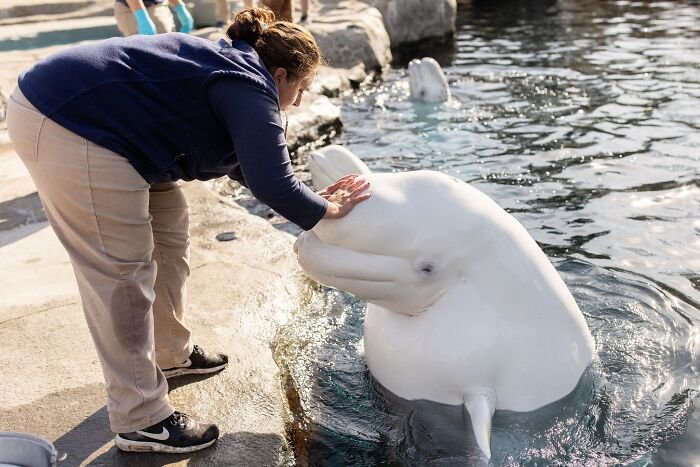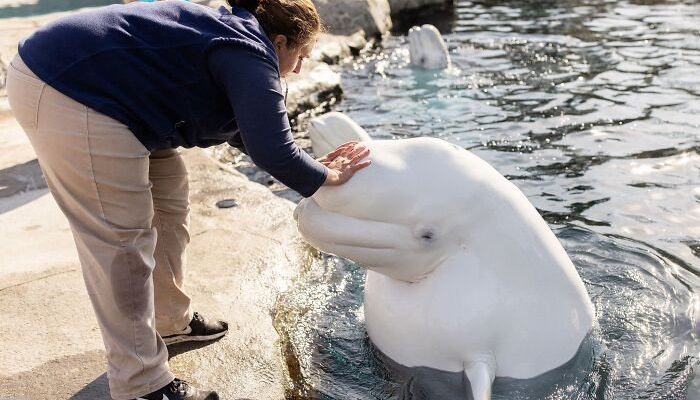
Beluga whales, often called the “canaries of the sea,” are known for their vocalizations and social behaviors. They’re intelligent and, in many cases, friendly—traits that can make human interaction seem appealing. However, there are several important factors to consider, like safety, ethics, and the well-being of these magnificent creatures. So, let’s dive in and explore how humans can safely engage with belugas, and what precautions we should take along the way.
Understanding Beluga Whales: Their Nature and Behavior
Beluga whales are fascinating animals. They can grow up to 18 feet long and weigh around 3,000 pounds! But their size doesn’t fully capture their charm. With their white skin and expressive faces, they often appear playful and curious. Belugas are particularly known for their sounds, which range from clicks to whistles. By using these vocalizations, they communicate with each other—almost like a conversation in a bustling café.
What’s intriguing about these whales is their social structure. They often travel in pods, which can include anywhere from a few to several dozen belugas. This social behavior is key when considering interactions. When you think about it, their natural inclination for community can affect how they react to human presence. Can you imagine feeling threatened in a communal setting? It’s crucial to remember that they are not pets; they are wild animals with instincts and emotions.
So, when we talk about interacting with belugas, it’s vital to acknowledge their nature. Respecting their behavior and understanding their social interactions help ensure safety for both humans and whales alike.
The Importance of Safety Protocols
When it comes to interacting with belugas, safety should always be your top priority. Many organizations and facilities that offer the chance to swim or observe these whales closely have established safety protocols. For instance, they typically enforce guidelines that limit the number of people in the water at any given time. This helps prevent overwhelming the animals and provides a more controlled environment.
You might be wondering what some of these safety protocols include. Here’s a quick rundown:
- Maintain a safe distance: Always keep a respectful distance to allow the whales to approach on their own terms.
- Avoid loud noises: Minimize shouting or sudden movements, as this can startle the animals.
- Follow trained guides: If you’re participating in a tour, listen to your guides. They know the best practices for safe interaction.
These measures not only protect the whales but also ensure that humans can enjoy this once-in-a-lifetime experience without unnecessary risks.
Ethical Considerations of Interacting with Belugas
On top of safety, we need to dive into the ethical considerations of interacting with beluga whales. While swimming with these majestic creatures sounds thrilling, it raises important questions about animal welfare. The reality is that many belugas in captivity face challenges that can affect their health and happiness.
Belugas, as social creatures, thrive in their natural environment. Their habitats, like the Arctic and sub-Arctic waters, provide necessary challenges and stimuli that help them live fulfilling lives. When humans interact closely with them, especially in captivity, the risks of stress and injury can increase. Keeping this in mind, it’s essential to support programs and facilities that prioritize the well-being of these animals.
You might also consider whether it’s better to observe belugas in the wild. Eco-tours offer an opportunity to see these whales in their natural habitat, which can be a more ethical choice compared to captivity. An encounter like this allows you to appreciate their beauty while respecting their space.
Conservation Efforts and Their Impact
Another compelling aspect of human interaction with belugas is the connection to conservation efforts. Beluga whales are classified as “near threatened” due to habitat loss, pollution, and climate change. When people engage responsibly with these whales—whether through tours or educational programs—it can foster a greater awareness of their plight.
Many organizations work to protect beluga habitats and promote conservation efforts. Participating in responsible tourism can contribute to these initiatives. For instance, a portion of your tour fee might support local conservation projects or research. This way, your interaction helps protect the species while enhancing your understanding of the ocean’s ecosystems.
Here’s the thing: every little effort counts! Engaging responsibly with belugas allows you to be part of a larger conversation about marine life preservation.
How to Prepare for a Safe Interaction
If you’re excited about the prospect of interacting with belugas, being well-prepared is key. Start by selecting a reputable organization known for its ethical practices. Look for places that prioritize the welfare of the animals and have solid safety protocols in place.
Before you head out, consider these preparation tips:
- Do your research: Familiarize yourself with beluga behavior and the specific location you’ll be visiting.
- Wear appropriate gear: If you’re swimming, ensure you have the right wetsuit to stay warm in cooler waters.
- Mentally prepare yourself: Understand that interactions should be led by the animal, not by you.
By taking these steps, you ensure a smoother experience that respects both your safety and the whales’.
Alternative Ways to Connect with Belugas
If swimming with belugas feels too intense, there are plenty of other ways to connect with these unique creatures. For example, many aquariums offer educational programs that allow you to learn about belugas without direct interaction. These programs often involve behind-the-scenes tours where you can see how researchers care for the animals.
You could also participate in wildlife watching tours. These excursions let you observe belugas in their natural environment, allowing you to appreciate their behaviors while keeping a safe distance. It’s an incredible opportunity to witness their natural behaviors while supporting conservation efforts.
Remember, you can still have meaningful interactions without getting in the water. Just being present in their world can be rewarding and inspiring.
Interacting with beluga whales can be a magical experience, filled with joy and discovery. However, it comes with responsibilities that people must take seriously. By understanding their nature, prioritizing safety, and considering ethical implications, we can enjoy meaningful encounters while respecting these magnificent animals.
Whether you choose to swim with them or observe from a distance, the key is to celebrate their beauty and help protect their habitats. After all, every interaction is a chance to learn more about these amazing creatures and advocate for their future. So, gear up for your adventure, respect the whales, and cherish the precious moments in their world!

